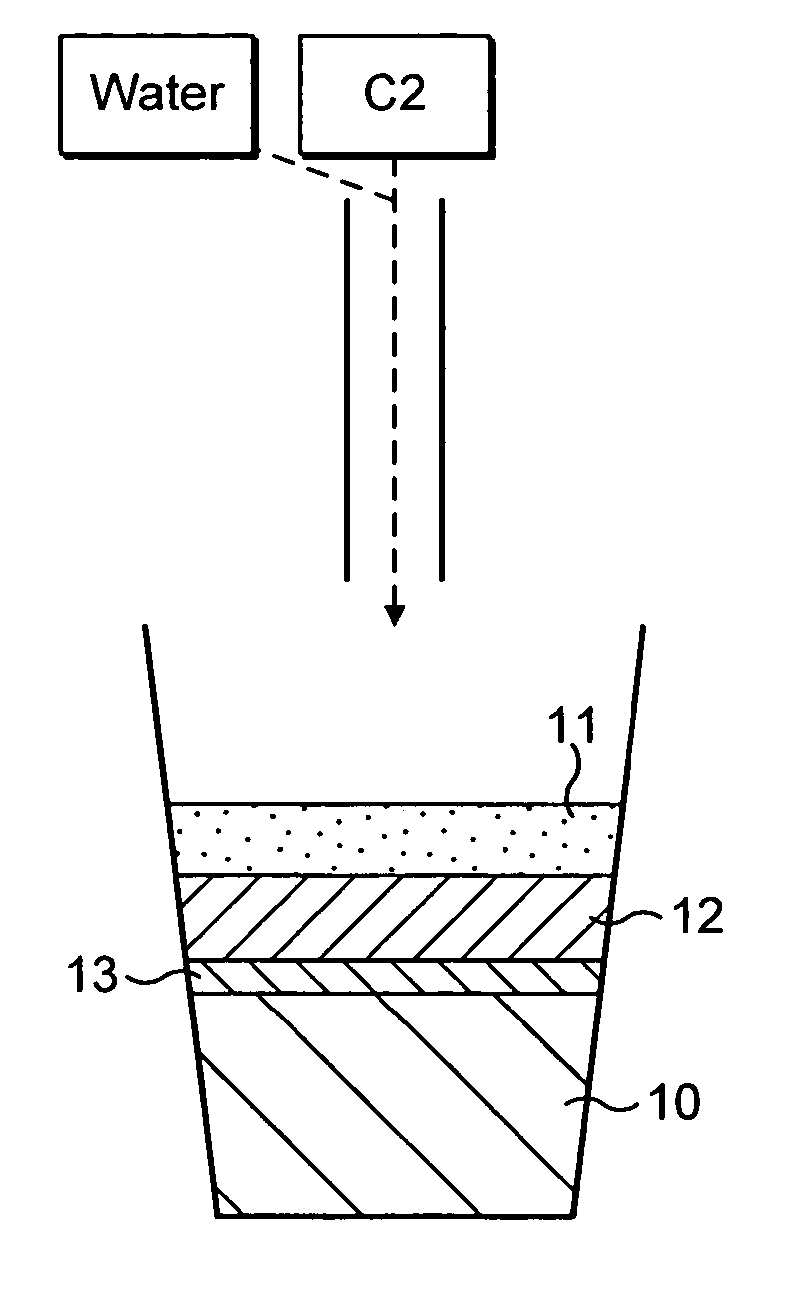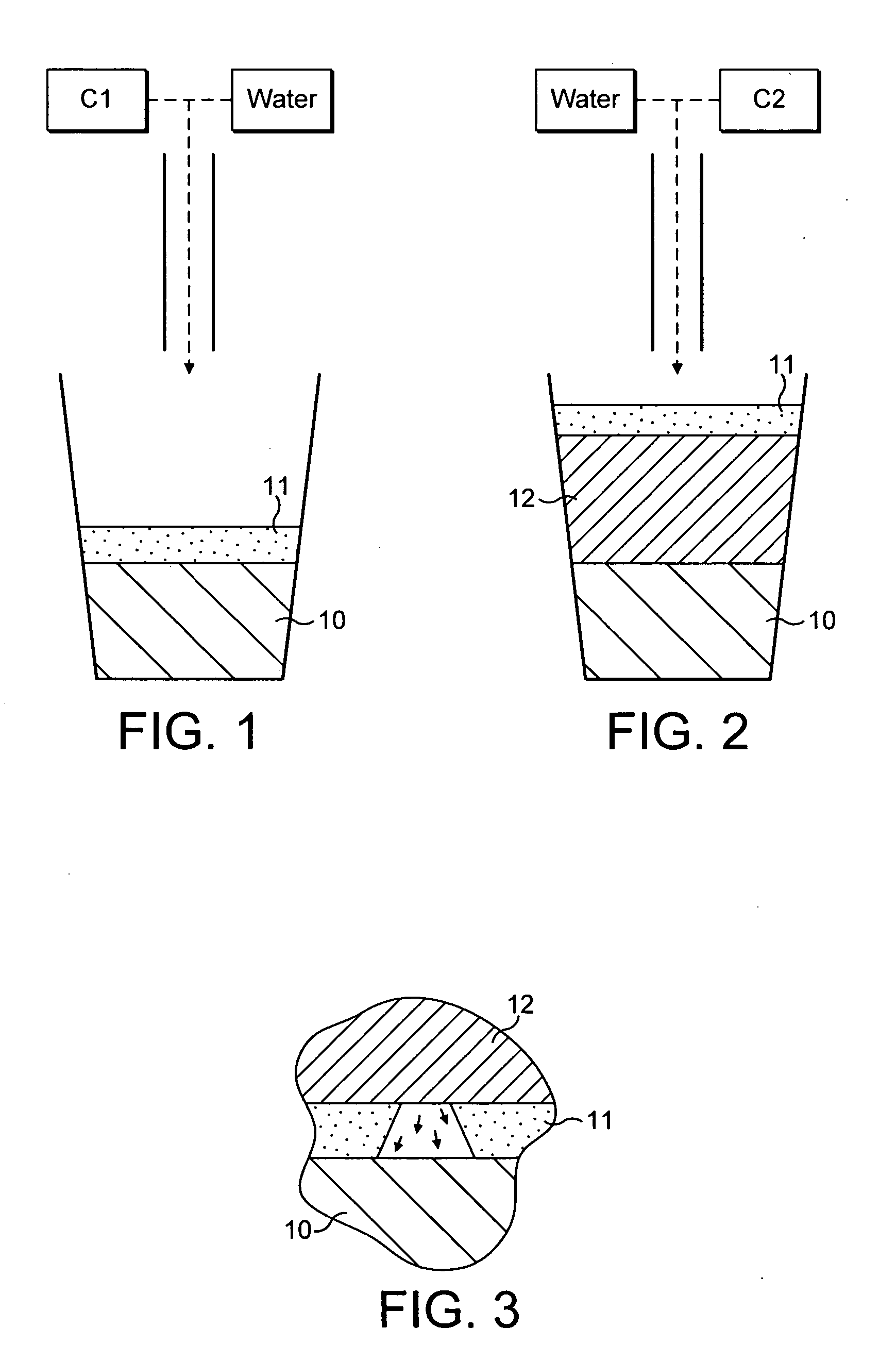Method and device for dispensing from liquid concentrates beverages having multi-layer visual appearance
a liquid concentrate and beverage technology, applied in the field of convenient dispensing, can solve the problems of manual preparation or cleaning, time-consuming and labor-intensive preparation, and inability to provide truly automatic dispensing
- Summary
- Abstract
- Description
- Claims
- Application Information
AI Technical Summary
Benefits of technology
Problems solved by technology
Method used
Image
Examples
example 1
[0087] A Cappuccino type beverage was prepared using the dispensing device of FIG. 7 from milk and coffee concentrates. A Cappuccino with two distinct layers was prepared using the following procedure. Temperature of water used was 85° C., and the concentrates were dispensed at ambient temperature (15-25° C.). The flow velocity of ingredients was 60 cm / s as measured from the nozzle.
[0088] Milk concentrate, at flow rate of 5.3 mL / s, for 10 sec, was first dispensed simultaneously with water at a flow rate of 6.9 mL / s. The whipper was turned on at the end of the cycle to create foam. This step was followed by dispensing water and residual milk remaining in the tubing, thus creating a layer at 70° C. Coffee concentrate, at flow rate of 2 mL / s, was dispensed lastly with water at same flow rate as for the first concentrate (6.9 mL / s but for 2 sec). Differences in density and temperature between the milk (1.024 g / cm3 at 55° C.) and coffee (0.996 g / cm3 at 77° C.) layers allowed them to rem...
example 2
[0089] A Cappuccino type beverage was prepared using a dispenser as in Example 1 from milk, coffee and sugar (50% wt) concentrates.
[0090] Milk was dispensed as in Example 1, followed by sucrose syrup at a flow rate of 3.8 nL / s, dispensed after 11 sec for 5 sec, and water and finally coffee concentrate mixed with water. The water and sucrose concentrate formed a density variation (1.024 (milk layer)>1.019 (sugar layer)>0.981 (coffee)) which allowed the coffee to partially distribute in multiple layers. The delivery rate was 7.5 mL / s.
[0091] Adding sugar to the formulation, helped to sweeten the product, and additionally enhanced layering in the beverage (FIG. 12).
example 3
[0092] A Cappuccino type beverage was prepared as in Example 1. The whipper was turned on immediately (no initial delay).
[0093] The milk layer at the bottom of the cup was significantly thinner than in Example 1. Having the whipper in on-mode created more turbulence and decreased (by incorporating more air) the density gradient between the milk and coffee fractions (FIG. 13).
PUM
| Property | Measurement | Unit |
|---|---|---|
| water flow rates | aaaaa | aaaaa |
| water flow rates | aaaaa | aaaaa |
| flow linear velocity | aaaaa | aaaaa |
Abstract
Description
Claims
Application Information
 Login to View More
Login to View More - R&D
- Intellectual Property
- Life Sciences
- Materials
- Tech Scout
- Unparalleled Data Quality
- Higher Quality Content
- 60% Fewer Hallucinations
Browse by: Latest US Patents, China's latest patents, Technical Efficacy Thesaurus, Application Domain, Technology Topic, Popular Technical Reports.
© 2025 PatSnap. All rights reserved.Legal|Privacy policy|Modern Slavery Act Transparency Statement|Sitemap|About US| Contact US: help@patsnap.com



